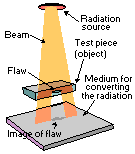Over two hundred radioactive isotopes are manufactured for use in medicine and industry. Radioisotopes can be used to analyze materials, trace flows and treat commodities.
Both slow neutrons for Thermal Neutron Capture (TNC) and fast neutrons for Neutron Inelastic Scattering (NIS) can be used to stimulate materials and reveal the elements that the sample contains. Lowering a NIS probe into a well can reveal the amount of water in the soil around the bore hole.
Gamma rays can be used to analyze the ash content of pieces of coal passing on a conveyor belt. This is useful for determining the amount of combustible material in the coal. X-rays can cause materials to fluoresce which reveals the types and amounts of elements present. A stream of mineral slurry can be probed to determine what elements are present.
A small capsule of radioactive material which emits gamma rays can be placed on one side of an object with a photographic plate or detector on the other side. This "radiographic" procedure is often used to check welds and joints in pipes and other metal objects. X-rays can also be used for radiography but gamma probes are more powerful and more portable.
Gamma rays can be used to determine the presence, absence, density or quantity of a material without any contact. Thus the flow of materials through a pipe can be easily monitored in processing industries.
Gamma rays are widely used to sterilize a variety of objects, materials and commodities. Medical equipment, wool, wood, archival documents, food and other things are treated with gamma rays.
Most physical, chemical and biological systems do not react differently to radioactive or non-radioactive materials. Radioisotopes can be inserted into molecules to replace the non-radioactive version of a particular element. The molecule is then introduced into a system and traced as it moved through. Flows of water and movements of soil can be traced with naturally occurring radioisotopes.
Small quantities of radioisotopes with short half-lives can be introduced into flows and used to monitor mixing and dilution. Outflows of sewage, industrial mixing, blast furnace mixing and even insect infestation can be traced.
Naturally occurring radioactivity in ores can be concentrated by processing and may pose an industrial hazard which must be dealt with. Oil and natural gas processing can contaminate large amounts of water. Coal burning concentrates radioactivity in the resulting ash. Pulverizing rocks containing phosphate for fertilizer concentrates natural radioactivity. Cleaning water for human use results in waste products that contain radioactivity. Metal smelting can concentrate radioactive materials in the ores. Particle acceletators used for physics research generate radioactivity that must be disposed of when an accelerator is decommissioned. Some radiation sources used in research in commercial laboratories and universities have a long half-life and pose a disposal.
Both natural and man-made radioactive materials are widely used in our advanced technological culture. Their production, handling and disposal require careful monitoring.
